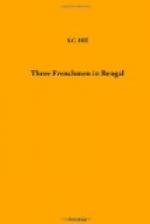[Footnote 128: Calcapur, the site of the Dutch Factory. See note, p. 64.]
[Footnote 129: From a map by Rennell of the neighbourhood of Dacca it appears that the French Factory was on the River Bourigunga. There are still several plots of ground in Dacca town belonging to the French. One of them, popularly known as Frashdanga, is situated at the mouth of the old bed of the river which forms an island of the southern portion of the town; but I do not think this is the site of the French Factory, as the latter appears to have been situated to the west of the present Nawab’s palace.]
[Footnote 130: Now used in the sense of messengers or office attendants.]
[Footnote 131: Orme says (bk. viii. p. 285) that Courtin started with 30 Europeans and 100 sepoys. From Law’s “Memoir” we see that M. de Carryon took 20 men to Cossimbazar before Law himself left. This accounts for the smallness of Courtin’s force.]
[Footnote 132: Jafar Ali Khan married the sister of Aliverdi Khan, Siraj-ud-daula’s grandfather.]
[Footnote 133: I think he must mean the mouth of the Murshidabad River.]
[Footnote 134: Courtin means the lower ranges of the Himalayas, inhabited by the Nepaulese, Bhutiyas, etc. His wanderings therefore were in the districts of Rungpore and Dinajpur.]
[Footnote 135: Sinfray, Secretary to the Council at Chandernagore, was one of the fugitives who, as mentioned above, joined Law at Cossimbazar.]
[Footnote 136: Assaduzama Muhammad was nephew to Kamgar Khan, the general of Shah Alam. Holwell. Memorial to the Select Committee, 1760.]
[Footnote 137: Orme MSS. India XI., p. 2859, No. 246.]
[Footnote 138: Orme says the Fort was on the River Teesta, but Rennell marks it more correctly a little away from the river and about fifteen miles south of Jalpaiguri.]
[Footnote 139: These guns Courtin calls “pieces a la minute.” The proper name should be “canon a la suedoise” or “canon a la minute.” They were invented by the Swedes, who used 3-pounders with improved methods for loading and firing, so as to be able to fire as many as ten shots in a minute. The French adopted a 4-pounder gun of this kind in 1743. The above information was given me by Lieut.-Colonel Ottley Perry, on the authority of Colonel Colin, an artillery officer on the French Headquarters Staff.]
[Footnote 140: This squadron, under the command of Mons. Bouvet, actually did arrive.]
[Footnote 141: This rebellion was really conducted by Ukil Singh, the Hindoo Diwan of Hazir Ali.]
[Footnote 142: Mir Jafar, Jafar Ali, Mir Jafar Ali Khan, are all variations of the name of the Nawab whom the English placed on the throne after the death of Siraj-ud-daula.]
[Footnote 143: Law says that the French soldiers who wandered the country in this way were accustomed to disguise themselves as natives and even as Brahmins, when they wished to avoid notice.]




